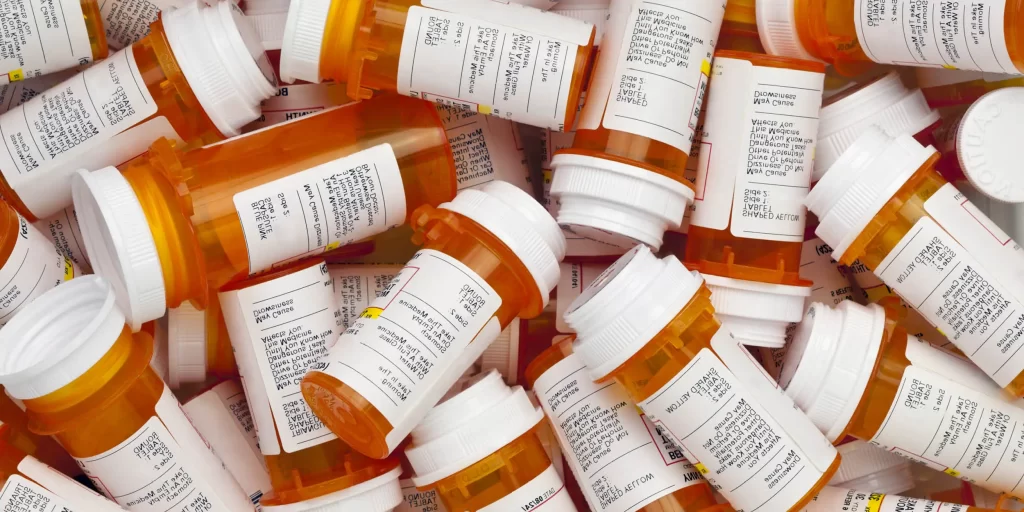How Long Do Prescription Drugs Stay in Your System?
Written by Thomas Christiansen
& Medically Reviewed by Dr. Annie Tye, PhD
Medically Reviewed
Up to Date
Last Updated - 6/17/2022
View our editorial policy
Prescription drug misuse is widespread in the United States. An estimated 6% of Americans misused prescription drugs at least once in 2017. Consequences of prescription drug misuse can range from lost jobs and irresponsible parenting to homelessness and violent crime.
Several factors affect how long prescription drugs remain in your system. Some of those factors include age, mental health status, metabolism. Other factors include what class of drug was used, what the drug is composed of, and the frequency of usage.
The three most commonly misused prescription drug classes are central nervous system (CNS) depressants, stimulants and opioids.
- CNS depressants: CNS depressants including benzodiazepines are prescribed to treat anxiety and panic disorders. People misuse them for their euphoric effects. Benzodiazepines can remain in your system for between 10 hours and 17 days after use.
- Stimulants: Stimulants are prescribed to treat ADHD and narcolepsy. People misuse stimulants to improve attention, alertness and for a euphoric rush. Stimulants can remain in your system for between 10 hours and three days after use.
- Opioids: Opioids are prescribed to treat severe pain. People misuse opioids for their euphoric effects. Opioids can remain in your system for between five hours and 12 days after use.
Prescription Drugs Duration of Effects
Benzodiazepine, stimulant and opioid drug classes contain many different types of substances. Brand name versions further increase the number of available prescriptions in those drug classes. Always consult with your doctor about the specific prescriptions you’re taking and their individual duration of effects. The following data represents ranges for all generic drugs in each class and does not differentiate between slow, intermediate and fast onset.
- Initial onset: 15 to 60 minutes
- Peak blood plasma: 1 to 2 hours
- Duration of effects: 6 to 12 hours
- Initial onset: 20 to 90 minutes
- Peak blood plasma: 6 to 9 hours
- Duration of effects: 3 to 10 hours
- Initial onset: 5 to 60 minutes
- Peak blood plasma: 30 minutes to 3 hours
- Duration of effects: 3 to 6 hours
Half-Lives of Prescription Drugs
A drug’s half-life is the amount of time for half of the drug to be metabolized. For example, if you took 1 gram of a drug that had a 10-hour half-life, 10 hours after taking the drug you would have half of a gram (500 milligrams) remaining in your system.
Chronic use of a drug typically increases the amount of time the drug remains in your system. To estimate how the half-life of a drug translates to the detection window of a urine test is to multiply the half-life by five.
- Benzodiazepines have half-lives ranging from 3 hours to 97 hours
- Stimulants have half-lives ranging from 2 to 13.8 hours
- Opioids have half-lives ranging from 1 hour to 59 (or more due to polymorphisms) hours
Prescription Drug Screening Detection Times
Due to the diversity of individual drug half-lives represented in each of the three classes of commonly misused prescription drugs, data representing detection times can only be provided in ranges. Prescription drugs are detectable in urine for a bit longer than blood or saliva. Most standard drug tests are qualitative tests that use a predetermined cut-off amount to determine if the test is positive or negative. Quantitative tests report on the actual amount of drug measured.
The following are general estimates of the amount of time required for the drug to fall below detectable levels in a qualitative test.
Urine
Urine tests are the most common drug testing method. They can determine whether the drug or its metabolites are present.
- Benzodiazepines: can be detected by urine tests for one to six weeks
- Stimulants: can be detected by urine tests for three to five days
- Opioids: can be detected by urine tests for two to three days
Blood
Blood tests can evaluate parent drug concentrations as well as metabolites. They are often considered to be the most reliable test available. However, they are invasive and require a trained professional to collect the sample.
- Benzodiazepines: can be detected by blood tests for 6 to 48 hours
- Stimulants: can be detected by blood tests for 12 hours
- Opioids: can be detected by blood tests for two to five days
Saliva
Saliva includes diffused blood plasma, so it can be reliably used to detect recent drug use (from a few hours to a maximum of a few days). Saliva tests are not used for detecting drug metabolites.
- Benzodiazepines: can be detected by saliva tests for 6 to 48 hours
- Stimulants: can be detected by saliva tests for 12 hours
- Opioids: can be detected by saliva tests for two to five days
Hair
Hair tests evaluate hair follicles, which retain evidence of drug use for substantially longer amounts of time than urine, blood or saliva tests.
- Benzodiazepines: can be detected by hair tests for more than 90 days
- Stimulants: can be detected by hair tests for more than 90 days
- Opioids: can be detected by hair tests for more than 90 days
Factors Affecting How Long Prescription Drugs Stay in Your System
Factors that contribute to the length of time that prescription drugs stay in your system include:
- Type of drug: Chemical compositions can profoundly affect the length of time that drugs will stay in your body. For example, water-soluble drugs (stimulants and opioids) tend to be absorbed and excreted faster than fat-soluble drugs (benzodiazepines).
- Frequency of use: Chronic prescription drug use will cause the drug to build up in your system, meaning that more time will be required for the body to eliminate the drug.
- Amount used: Like frequency, using large amounts of a drug will cause an increased concentration of the drug in your system.
- Metabolism: A fast metabolism can speed up the amount of time required to eliminate a drug.
- Overall health: Poor health often correlates with an increased amount of time required to rid your system of prescription drugs.
False Positives for Prescription Drug Use
Data suggests that between 5% and 10% of drug tests result in false positives, and some reports indicate that saliva tests have a false positive rate of up to 30%. There are many prescription drugs that can make you fail a drug test, and there are also common over-the-counter drugs and foods that can affect the validity of a drug test.
The following is a partial list of drugs that can cause false positives:
- Benzodiazepines: Efavirenz, NSAIDs, sertraline
- Stimulants: Amantadine; bupropion, chlorpromazine, ranitidine, trazodone
- Opioids: Dextromethorphan; diphenhydramine, quinine, rifampin, verapamil
How Prescription Drugs are Broken Down in the Body
Pharmacokinetics is the study of how drugs move through and are broken down by the body. There are four basic stages of pharmacokinetics:
- Absorption
- Distribution
- Metabolism
- Excretion
A drug that is taken orally is absorbed in the digestive tract and is then distributed to the bloodstream, which transports the drug to the proper organs.
All drugs that enter the bloodstream are eventually transported to the liver, which metabolizes (i.e., breaks down) the drugs before they are excreted via urine or feces. Other routes of drug administration have different absorption and distribution patterns, but all drugs will eventually reach the liver and be excreted.
If you or a loved one struggle with a substance abuse disorder, contact The Recovery Village Ridgefield today. Call to speak with a representative about how addiction treatment can help. Take the first step toward a healthier future, call today.
Sources
National Institute on Drug Abuse. “Misuse of Prescription Drugs.” December 2018. Accessed August 9, 2019.
National Institute on Drug Abuse. “Prescription Stimulants.” June 2018. Accessed August 9, 2019.
Lee-Iannotti, Joyce; Parish, James. “Suvorexant: a promising, novel treatment for insomnia.” Neuropsychiatric Disease and Treatment, February 2016. Accessed August 9, 2019.
Williams, Shannon. “Recent Treatment Options for ADHD.” U.S. Pharmacist, 2008. Accessed August 9, 2019.
Texas.gov. “Onset, Peak and Duration of Common Pain Medications.” Accessed August 9, 2019.
Craven, Caroline; Fileger, Monica; Woster, Patricia. “Demystifying Benzodiazepine Urine Drug Screen Results.” Practical Pain Management, February 2014. Accessed August 9, 2019.
Piper, Brian; Ogden, Christy; Simoyan, Olapeju; Chung, Daniel; Caggiano, James; Nichols, Stephanie; McCall, Kenneth. “Trends in use of prescription stimulants in the United States and Territories, 2006 to 2016.” PLoS One, November 2018. Accessed August 9, 2019.
Fudin, Jeffrey; Ahmed, Nabeela; Horlacher, Randall. “Opioid Withdrawal: A New Look at Medication Options.” Practical Pain Management, January 2019. Accessed August 9, 2019.
Dessauer, Paul. “Are You Taking the Piss? Understanding Results from Drug Testing.” Accessed August 9, 2019.
Accutest. “What are the detection periods?” Accessed August 9, 2019.
Eske, Jamie. “What to know about hair follicle drug tests.” Medical News Today, April 2019. Accessed August 9, 2019.
Drugs.com. “Can a Drug Test Lead to a False Positive?” June 2017. Accessed August 9, 2019.
Davis, Alison. “Medicine’s Journey Through the Body: 4 Stages.” National Institute of Health Live Science, April 2014. Accessed August 9, 2019.
View Sources
National Institute on Drug Abuse. “Misuse of Prescription Drugs.” December 2018. Accessed August 9, 2019.
National Institute on Drug Abuse. “Prescription Stimulants.” June 2018. Accessed August 9, 2019.
Lee-Iannotti, Joyce; Parish, James. “Suvorexant: a promising, novel treatment for insomnia.” Neuropsychiatric Disease and Treatment, February 2016. Accessed August 9, 2019.
Williams, Shannon. “Recent Treatment Options for ADHD.” U.S. Pharmacist, 2008. Accessed August 9, 2019.
Texas.gov. “Onset, Peak and Duration of Common Pain Medications.” Accessed August 9, 2019.
Craven, Caroline; Fileger, Monica; Woster, Patricia. “Demystifying Benzodiazepine Urine Drug Screen Results.” Practical Pain Management, February 2014. Accessed August 9, 2019.
Piper, Brian; Ogden, Christy; Simoyan, Olapeju; Chung, Daniel; Caggiano, James; Nichols, Stephanie; McCall, Kenneth. “Trends in use of prescription stimulants in the United States and Territories, 2006 to 2016.” PLoS One, November 2018. Accessed August 9, 2019.
Fudin, Jeffrey; Ahmed, Nabeela; Horlacher, Randall. “Opioid Withdrawal: A New Look at Medication Options.” Practical Pain Management, January 2019. Accessed August 9, 2019.
Dessauer, Paul. “Are You Taking the Piss? Understanding Results from Drug Testing.” Accessed August 9, 2019.
Accutest. “What are the detection periods?” Accessed August 9, 2019.
Eske, Jamie. “What to know about hair follicle drug tests.” Medical News Today, April 2019. Accessed August 9, 2019.
Drugs.com. “Can a Drug Test Lead to a False Positive?” June 2017. Accessed August 9, 2019.
Davis, Alison. “Medicine’s Journey Through the Body: 4 Stages.” National Institute of Health Live Science, April 2014. Accessed August 9, 2019.
Authorship






